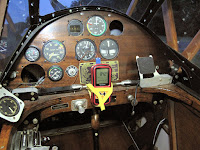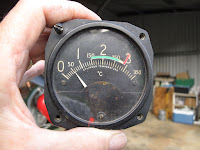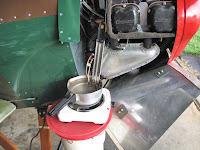While Taxiing the plane I didn't have any reading on the Cylinder Head gauge nor the Oil Temperature gauge. It turns out both gauges are dead. Despite the fact that everything worked when I took the plane apart I should have checked all the gauges before putting them back in. Only the oil pressure and tachometer seem to work correctly, even the clock is dead.
The cylinder head temperature gauge is WWII surplus, so no shock it's quit working. It was built by The Lewis Eng. Co. P/N 17AT4P.
It uses a thermocouple to measure the temperature. On the back it says to "Use 2 Ohm CC Leads". The large nut is marked "+" and the small one "-".
OK, what's all that mean?
After 3 books on instruments and several web sites I think I've got it. A thermocouple is made by joining 2 wires of different metals. When that junction is heated it produces a voltage which is measured by the gauge. The gauge is basically a voltmeter marked in units of temperature instead of volts. There are about 8 common combinations of wire used to make thermocouples. The website
thermocoupleinfo.com has lots of explanations and data to help select an appropriate thermocouple.
The gauge also has a thermocouple in it, made of the same wires, so that it compensates for ambient temperature. It's really measuring the difference between the 2 thermocouples so the positive (+) and negative (-) leads need to be connected to the correct terminal for the gauge to read the head temperature correctly. There is an adjustment screw on the front of the Lewis gauge. You're not adjusting the pointer to zero but to the ambient temperature. Once set it doesn't require regular adjustment.
There are 2 common thermocouples types used for aircraft cylinder head temperature. The first is Type J which is made with an Iron wire and a wire made of Constantan.
Here we go again, what on earth is Constantan. It's a wire made mostly from 2 metals, Nickel (about 45%) and Copper (about 55%), and bits of some others. Constantan gets it's name from the fact that it's Electrical Resistance is Constant (doesn't very much) as the temperature changes. Because of this property, it is used to make Strain Gauges, for measuring forces acting on structural parts. I would love to digress on strain gauges but not now.
Back to our Type J thermocouple. It needs a gauge with the internal thermocouple made with Iron and Constantan. The back of the Lewis Iron-Constantan gauges are marked "IC Leads". The Iron lead is the Positive (+) and Constantan is the Negative lead (-). The old Style 18mm spark plug J Type thermocouples have Black Insulation on the Iron Lead and White on the Constantan lead. You can also check to see if a magnet sticks to the iron lead. Modern Type J wire has White Insulation on the Iron lead and Red on the Constantan.
Here's some of the information from Thermocouples.com.
The other common cylinder head thermocouple is a T Type. They are made with a Copper wire and a Constantan Wire. The back of the Lewis Copper-Constantan gauges, like mine, are marked "CC Leads". The Copper lead is the Positive (+) and Constantan is the Negative lead (-). The old Style 18mm spark plug T Type thermocouples have Red Insulation on the Copper Lead and White on the Constantan lead. A magnet will not stick to the copper lead. Modern Type T wire has Blue Insulation on the Copper lead and Red on the Constantan.
Iron-Constantan thermocouples generate a little more voltage than Copper-Constantan, at the same temperature. Iron can also go to much higher temperatures, but both can go well above the maximum cylinder head temperature, 540 Degrees F for my C-85.
For the gauge to read correctly the important voltage is what is available at the gauge. The résistance of the lead wires reduces the voltage generated at the thermocouple by the time it gets to the gauge. The longer the wires the lower the voltage at the gauge. So how long should the leads be to read the temperature correctly? The answer is on the back of the gauge, "Use 2 Ohm CC Leads". If the leads have 2 Ohms of resistance the Lewis gauge will read correctly. The trick then is to cut the leads to length so they have precisely 2 Ohms of resistance.
The old Lewis gauge is dead so I've temporally made use of my Digital Multimeter as a temperature gauge. It has a temperature function. As it turns out it uses a Copper-Constantan thermocouple (Blue/Red wires). I don't want to mess with the length of the leads for a temporary solution so I decided to just calibrate what I have so I'll know what reading keeps the head temperature within limits.
I started by using Boiling Water, on my little hot plate. Water boils at 212 degrees F. The meter is reading 218 degrees F.
To get to higher temperatures I'm using Canola Oil which can easily go to the limits of my candy thermometers, 400 Degrees F.
With the oil at 332 Degrees F the meter reads 362 Degrees F.
I've pushed the oil up to 410 Degrees F and the meter reads 458 Degrees F.
I've plotted the data. If I keep the meter between 310 and 500 Degrees F I'll be in the normal operating range of 300 - 460 Degrees F.
I made up some short leads to connect the existing leads to the meter, before I did my testing. The meter is very light so I've attached it to the big turnbuckle with some double sided Velcro.
I taxied around with it and it works fine, easy to read.
My next task was the Oil Temperature gauge. I ordered a new Rochester gauge from Spruce. I checked it's calibration with boiling water. It reads about 10 Degrees F low so I'll put the red line at 210 Degrees instead of the 220 Degrees F listed in the manual.
This gauge uses a Bourdon Tube pressure gauge marked to read temperature. The tube is a curved thin copper tube which moves to uncoil as pressure is increased. This pulls the link which moves the sector gear, turning the pointer.
For a temperature gauge the pressure source is a sealed tube, capillary, filled with something like Methyl Chloride. As the bulb at the end of the tube gets heated, in this case by hot motor oil, the fluid expands causing the pressure to move the needle.
The hard part was getting the old gauge out and the new gauge in. I had to remove the cowl panel with the windshield riveted to it. The last time I did this I took off the wing center section. I was not interested in taking off the wings. A lot of careful wiggling and I managed to remove it.
I had wrapped the primer lines, ignition wires and the gauge's capillary tube with friction tape and then securely clamped this group to the wooden tank support. The rear clamp was just aft of the tank, and fairly easy to unscrew. The forward clamp is just under the tank above the rudder pedal. I had to lay down in the fuselage, remove the clamps and friction tape, and then get back out to remove the gauge. It took a very short screw driver, and many tries, to get the bottom screw removed so the clamp could be pried up enough to remove the bundle. I should have put that clamp forward of the tank.
Before I installed the new gauge I put some white electrical tape on the capillary to mark where the friction tape would wrap everything, using the old tube as a guide.
It took some wiggling to snake the new capillary tube in the right place and then through the hole in the firewall. Once I was sure it was routed correctly I clamped the new gauge in the panel, so it would be rotated to the right position. Then I coiled up the excess tubing and screwed the bulb into the adapter on the back of the oil screen, on the motor.
Then back into the fuselage with some new friction tape to re-wrap everything and re-screw the clamps. The whole process went well but took a couple hours.
The new gauge is in and marked. I've now got the cowl back together and will do some taxiing, to check that it all works.
We're getting close to flying. Yeah!!



























